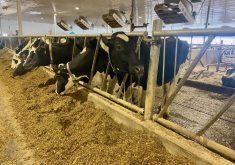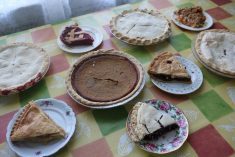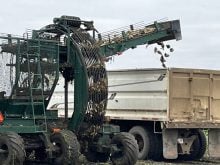I have been trying to eliminate chocolate from my diet. It seems to be a losing battle. Knowing how much I like chocolate, our daughter, Marla, e-mailed this rationalization to me just before Valentine’s Day. I laughed.
About chocolate
- Chocolate is derived from cocoa beans. Bean = vegetable.
- Sugar is derived from either sugar cane or sugar beets. Both of them are plants, in the vegetable category. Thus, chocolate is a vegetable.
- Chocolate candy bars also contain milk, which is dairy. So, candy bars are a health food.
- Chocolate-covered raisins, cherries, orange slices and strawberries all count as fruit, so eat as many as you want.
Read Also

Accurate accounting, inventory records are important
Maintaining detailed accounting and inventory records is not just a best practice; it’s a critical component of financial health, operational efficiency and compliance with programs like AgriStability.
Biscotti recipe
In reply to an earlier request for macadamia white chocolate cookies, M.W., Hodgeville, Sask., sent this recipe for biscotti, a hard cookie used for dipping in hot drinks.
13/4 cups flour 425 mL
2 teaspoons baking 10 mL
powder
3/4 cup chopped nuts 175 mL
(macadamia, unblanched almonds)
1/2 cup dried 125 mL
cranberries (optional)
Mix together.
Combine:
1/3 cup butter, melted 75 mL
3/4 cup sugar 175 mL
2 eggs
2 teaspoons vanilla 10 mL
Add to the dry ingredients. Stir well. Form dough into a ball, then divide in half. Place each ball on an ungreased baking sheet. Form each ball into a log. Brush each top with slightly beaten egg whites. Bake at 350 F (180 C) for 20 minutes. Remove from oven and cool for five minutes. Cut each log diagonally into strips (bars). Return to oven and bake another 20 minutes. Cool.
Ready for pickles
Dear TEAM: Despite the biblical plagues of last year’s gardening season, I am looking forward to this season and canning. Do you have a dill pickle recipe that allows you to put the cucumbers, dill, garlic, spice and brine directly into jars and then to a standard canner? I would really like to skip that step of soaking in a crock and then canning the pickles. – E.G., Saskatoon, Sask.
Dear E.G.: This recipe comes from Bernardin. For information, call its consumer services at 416-239-7723 or visit the website www.homecanning.com.
Fresh pack dill pickles
Icing the cucumbers in a cold saltwater solution before pickling enhances their crispness. Select uniformly shaped, firm cucumbers about four to six inches (10-15 cm) long. Use odd-shaped and more mature cucumbers for relishes and sliced pickles.
Store pickles for three weeks to allow flavours to develop. A bushel weighs 48 pounds (21.7 kilograms) and yields 16-24 litres – an average of two pounds (900 g) per L.
Ingredient quantities are approximate. Variations in sizes of pickling cucumbers and jar size dictate how many pickles can be placed in each jar. This in turn affects the quantity of liquid required. (See chart below.)
Wash cucumbers, scrubbing lightly with a vegetable brush. Rinse in cool water. Cut 1/8 inch (three millimetres) slice off blossom end, opposite the stem end, and discard. Layer cucumbers and ice in a large, deep glass or stainless steel container. Dissolve pickling salt in quantity of water listed in “overnight icing,” then pour over cucumbers. Add cold water to just cover the cucumbers. Fill a plastic bag with water and place over ice and cucumbers to keep vegetables submerged. Refrigerate overnight.
Preserving day
Place the required number of clean jars in a boiling water canner; fill with water, and bring to a rolling boil. Boil the lids five minutes – not longer – to soften sealing compound; let stand in hot water until ready to use.
Prepare pickling liquid. In a large stainless steel saucepan, combine water, vinegar, pickling salt and sugar in quantities for the size of jars you are preparing. Tie pickling spice in a large square of cheesecloth, creating a spice bag. Add it to the saucepan and bring to a boil, cooking for 15 minutes.
Drain cucumbers and discard soaking solution. Remove hot jars from canner and fill. In each jar, place the quantity of dill, mustard seed and garlic indicated for the size of jar you are using. Pack cucumbers in the jar to within 3/4 in. (two cm) of the rim.
Add pickling liquid to cover the cucumbers to within half inch (one cm) of top rim. Using non-metallic utensil, remove air bubbles. Wipe jar rim, removing any stickiness. Centre lid and apply screw band securely until fingertip tight. Do not overtighten. Place jar in canner. Repeat for remaining herbs, cucumbers and pickling liquid.
Cover canner and return water to a boil. Boil the filled jars for times shown:
Jar size Processing time*
500 mL 10 minutes
1 L 15 minutes
1.5 L 20 minutes
- At altitudes higher than 1,000 feet (305 m), increase processing time as indicated in chart below.
Boiling water canner – altitude adjustments
Altitude Sterilization/processing time
Feet Metres
1,001-3,000 306-915 5 minutes
3,001-6,000 916-1,830 10 minutes
6,001-8,000 1,831-2,440 15 minutes
8,001-10,000 2,441-3,050 20 minutes
500 mL jars x 7 1 L jars x 7 1.5 L jars x 5
Overnight icing:
Pickling cucumbers 8 pounds (3.6 kg) 14 pounds (6.3 kg) 15 pounds (6.8 kg)
Ice 4 L 4 L 4 L
Water 4 cups (1 L) 8 cups (2 L) 12 cups (3 L)
Pickling salt 1/2 cup 1 cup 1 cup
Pickling liquid:
Water 8 cups 16 cups 16 cups
White vinegar (5 %) 6 cups 12 cups 12 cups
Pickling salt 3/4 cup 11/2 cups 2 cups
Granulated sugar 1/4 cup 1/2 cup 1/2 cup
Whole mixed pickling 2 tablespoons 4 tablespoons 4 tablespoons
spice
Quantity to pack per jar:
Whole mustard seed 1 teaspoon 2 teaspoons 1 tablespoon
Fresh dill heads 1 1/2 heads 2-3 heads 4-5 heads
or dill seed or dill weed 1 tablespoon 2 tablespoons 3 tablespoons
Peeled cloves garlic 1 2-3 3-4
When processing time is complete, turn off heat and allow boil to subside. Lift jars, without tilting, and place upright on a board or towel in a draft-free place. Let cool undisturbed, for 24 hours. Do not retighten screw bands. After cooling, check jar seals. Sealed lids curve downward. Remove screw bands; wipe and dry bands and jars. Store screw bands separately or replace loosely on jars. Label and store in a cool, dark place.
Barbara Sanderson is a home economist from Rosetown, Sask., and one of four columnists comprising Team Resources. Send correspondence in care of this newspaper, Box 2500, Saskatoon, Sask., S7K 2C4 or contact them at team@producer.com.














